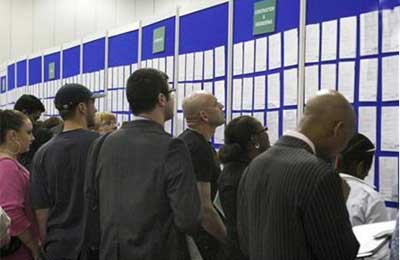
Superstorm Sandy to dampen US payrolls
Washington, December 7, 2012
Superstorm Sandy likely put a dent in US employment growth in November, temporarily interrupting a recently established trend of modestly rising payrolls.
Nonfarm employment is forecast to have increased by a paltry 93,000 jobs last month after advancing by 171,000 in October, according to a Reuters survey of economists. The unemployment rate is seen holding steady at 7.9 percent.
November's anticipated job count would be the smallest in five months. Economists said the slowdown will reflect the effect of the late-October storm, which battered the densely populated East Coast. A snap back is expected in December.
"Sandy is going to depress payroll employment growth in November, but I expect it to rebound in December," said Gus Faucher, a senior economist at PNC Financial Services in Pittsburgh.
Expectations for a December bounce back were bolstered by data on Thursday that showed first-time applications for state unemployment benefits dropped to the top end of their pre-storm range in the week ended Dec. 1.
The Labor Department will release the November employment report at 8:30 a.m. (1330 GMT) on Friday. Earlier reports have shown that Sandy restrained consumer spending and industrial production in October, while spurring a drop in wages.
Payroll growth averaged 170,000 per month over the three months before the storm struck, and economists expect job creation to pick up to around that level in the coming months.
That should be enough to push the jobless rate lower over time, but only slowly. Economists say roughly 200,000-250,000 jobs per month are needed to really make headway.
Businesses have been reluctant to spend and hire, fearful the government may fail to prevent the $600 billion in automatic tax hikes and government spending cuts set to take hold at the start of next year. The debt crisis in Europe has also weighed.
"Once Washington policymakers resolve the near-term fiscal and other policy challenges that have undermined business confidence, we expect the pace of recovery, and job growth to begin to accelerate next year," said Lewis Alexander, chief economist at Nomura Securities in New York.
Policymakers at the Federal Reserve who meet on Tuesday and Wednesday are not expected to take much notice of the report, given the expected storm-related distortions.
TIGHTER FISCAL POLICY IN 2013
Economists said an anticipated tightening of fiscal policy next year, even if a deal is reached to avoid completely going over the fiscal cliff, provides ample reason for the U.S. central bank to maintain its ultra-easy monetary policy stance.
"The Fed will want to do what it can to keep monetary policy easy. They would not want to do anything right now that would be a monetary tightening," said Jerry Webman, chief economist at Oppenheimer Funds in New York.
Relentless labor market weakness led the Fed in September to launch a program to buy $40 billion worth of mortgage-backed securities every month to drive down borrowing costs.
That is on top of a program dubbed "Operation Twist" in which it was re-weighting securities it holds toward longer maturities. Twist expires at the end of this month and economists expect the Fed to replace it with a program that buys government bonds with newly created money.
All of the meager jobs gains in November are expected to be in the private sector, with government employment seen falling 2,000.
Within the vast private services sector, retail and transport payrolls are expected to have been hit by the storm. In contrast, temporary help hiring likely got a boost from storm-related clean-up efforts.
In the goods-producing sector, manufacturing employment was probably flat, while post-storm rebuilding likely gave construction payrolls a lift. A rise in homebuilding, thanks to the Fed's accommodative policy stance, is another reason to look for an increase in construction jobs.
Average hourly earnings are expected to have edged up after slipping in October. In the 12 months to October, average hourly earnings rose just 1.6 percent, the lowest on records dating to early 2007.
While the length of the average workweek is expected to have held steady at 34.4 hours in November, the storm could have forced some companies to shorten hours.
"The economy has yet to enter a self-reinforcing virtuous growth cycle whereby improvements in purchasing power drive greater spending and hiring," said Julia Coronado, chief North America economist at BNP Paribas in New York.
"Much greater strength in hiring is required over a longer period to deliver stabilization in wage growth." – Reuters







